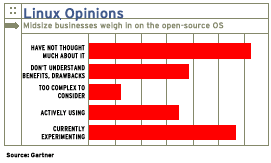Lining Up For Linux
While Torvalds says he doesn't focus very much on the strides Linux is making in the commercial world, he does realize that the success of the operating system with the penguin mascot relies heavily on a solid infrastructure,the libraries and tools that enable others to build applications on top of it. The importance of this, he says, is that "suddenly something that could have taken you 15 years to build, you actually have 15 years of infrastructure to build on,and you just add your piece. And that has been much more important, I think, than any single application in many ways." Now, with that infrastructure work completed, "we are in much better shape," he said.

\
As Linux vendors hone in on the SMB market, solution providers find themselves in a powerful position at a pivotal time
At LinuxWorld Expo this week, the industry at large will get a look at just how much better shape the open-source movement is in. One of the highly anticipated areas of progress is the move to bring Linux to small and midsize businesses. At the San Francisco event, key vendors are expected to reach beyond their previous enterprise focus and unveil a bevy of new Linux products and channel strategies tailored to the growing Linux SMB market.
These SMB initiatives, coming from vendors including Red Hat, IBM, Hewlett-Packard and Novell, are designed to capitalize on a market opening wide for open-source solutions. Research firm IDC says Linux now runs on more than 30 percent of all new servers shipped. And, according to research firm Gartner, roughly 17 percent of midsize businesses are actively using Linux, while another 28 percent are experimenting with it.
That puts the channel,the predominant vehicle for delivering IT solutions to the SMB market,in a powerful position at a pivotal time, especially since, according to Gartner, two-thirds of small businesses still don't have corporate networks. What's more, IDC said it expects software spending in the SMB market to rise to almost $30 billion by 2006 from $22.9 billion in 2002.
Vendors' new and expanded Linux channel programs are specifically targeted at this underserved SMB space. For example, as an expansion of its Value Advantage Plus (VAP) program, Armonk, N.Y.-based IBM is doubling the discount given to solution providers when they sell their applications and services to SMB customers in combination with with IBM software on Linux.
"It's sweet," said Doug Pelletier, president of Trifecta, an IBM partner based in Allentown, Pa., referring to the new 60 percent discount on IBM's Express Linux software for SMB deals. IBM is also using that 60 percent discount to court the channel partners of its Microsoft and Unix competitors, including SCO Group resellers and Windows ISVs and their channel partners, which have been marginalized by Microsoft's acquisition of Great Plains and Navision and its big push into the midmarket applications space. For example, accounting ISV AccPac, Pleasanton, Calif., has helped IBM more than quadruple the number of deals on its DB2 on Linux to more than 170. IBM is also pushing its Linux-based Express offering to the channels of Windows ISVs Sage, Intuit-Eclipse and Relevus.
Provo, Utah-based Novell, meanwhile, plans to exploit its sizable channel base to migrate customers to NetWare services on Linux. Later this year, the company plans to ship its Novell Nterprise Linux Services 1.0,which includes file, print, messaging and directory services,and is preparing a new Linux certification and training programs for partners. "Cost is a big reason to use Linux. Reliability seems to be another, although time will tell," said Scott Urbatsch, security specialist and engineer manager at Polar Systems, a Portland, Ore.-based Novell business partner. "The main differentiator is being able to run file and print, e-mail and accounting [packages] on Linux."


-- Ray Boggs, vice president of SMB research, IDC
Other Linux ISVs, such as UnitedLinux vendor SuSE and lesser-known ISV Trustix, have also launched new channel programs.
Many traditional Unix resellers have been pushing Linux for some time. Now, Windows ISVs and solution providers are beginning to follow suit. Chris Rivera, a network administrator at San Diego solution provider Nth-Systems, predicted that Linux could displace Windows in the SMB market as solution providers start to see increased profits. Nth-Systems is enjoying improved revenue by hosting an open-source e-mail program for SMB customers called SquirrelMail, Rivera said. "Smaller customers don't care about the technology," he said. "Linux will take over Microsoft because it's a more stable operating system, is easier to maintain, runs by itself, and the licensing for Windows is expensive. Our customers don't even know we run all their stuff on Linux."
While Redmond, Wash.-based Microsoft has strong brand awareness in the SMB market, several channel sources said Linux is becoming an easier sell there because smaller companies are very price-sensitive and more resistant than enterprise customers to Microsoft's Licensing 6.0 policies.
In addition, reliability problems associated with NT have been a major headache for VARs and their SMB customers, which often have few, if any, IT resources in-house. "The SMB market for Linux is very large," said Chris Maresca, president of Olliance Group, Palo Alto, Calif. "SMBs are focused mostly on reliability and cost, in that order. Reliability is far more important since most SMBs have smallish technical staffs."
With Microsoft slated to end NT Server support at the end of 2003, some SMBs that run those servers are evaluating whether switching to Linux makes sense, given the system licensing issues and staff retraining costs associated with migrating to Windows Server 2003 and .Net.
Server consolidation is turning out to be another strong pitch to SMB customers, solution providers said. "Linux definitely has a story [to tell] in the SMB space, because you can take a four-processor box and run multiple application images, and the cost of the software and support is less than a Windows box," said Kevin Gates, a senior Linux solutions specialist at Denver Solutions Group, Atlanta.
In the fourth quarter of 2002, the handful of unique Linux solution providers,such as Starnix, C-Tech Systems, Fly-By-Day Consulting and Olliance,stood out as risk-takers. However, now it's clear that Microsoft and Novell channel partners are looking for alternate revenue streams in the current tough economic environment. And Linux vendors are hoping to accommodate them with their new and expanded programs.
Red Hat and others flirted with channel programs in the past, but those efforts failed because their businesses were based on a services revenue model that conflicted with channel interests, analysts said.
But now, they said, those same vendors appear to understand what Microsoft has long understood about the SMB market,that to penetrate this space you have to target channel partners as your customers.

"All roads lead to Microsoft for small businesses, because that's what they've had," said Ray Boggs, vice president of SMB research at IDC. "But the needle is starting to move to Linux," he said. "From a networking perspective, the channel play becomes more critical because SMBs don't have a dedicated full-time MIS staff. Decisions come from the VARs, ISVs and systems integrators. VARs are hungry, and the channel is supportive of Linux because of the cost savings in licensing fees."
Two years ago, Microsoft executives were focusing all of their attention on moving customers from NT to .Net and detailing plans to build a partner ecosystem around .Net. Now, however, the rise of Linux in the SMB space,where Microsoft currently dominates,is clearly hovering over the company. Executives have said it is the No. 2 threat to the company's projected earnings in the future.
To fight back, Microsoft purchased server virtualization software for Windows 2003 from Connectix and is releasing a version of Windows Small Business Server 2003 priced at less than $1,000.
One Microsoft Certified Partner said he was able to snag some customers back to Windows after they encountered some problems with Linux. "We have seen some Linux activity. Recently, however, it has been in favor of Microsoft, not Linux," said Michael Cocanower, president of ITSynergy, Phoenix. "We are currently working with a large international musical instrument company that is dumping their entire Linux infrastructure and going back to Microsoft. They switched to Linux several years ago, and after running it for some time they found that, in fact, there is a higher total cost of ownership with Linux."
Still, many industry observers recognize the potential impact on Microsoft of a growing Linux channel in the SMB space. At Microsoft's recent annual financial meeting, for instance, one Wall Street analyst asked CEO Steve Ballmer how Microsoft planned to deploy solution providers to fight off Linux. Ballmer replied by saying that Microsoft's ace in the hole is its channel-friendly reputation. "We have a good position with VARs that serve the small and medium businesses," Ballmer said. "We're dialing up activity in the SMB space and doing enhancements in our programs for partners."
Perhaps one of the only things Microsoft and the Linux camp might agree on these days is that without a strong channel, Linux vendors won't be able to do to Microsoft in the SMB space what they did to Sun Microsystems in the enterprise market. "The direct route that worked with enterprises and government won't suffice in the SMB market," said Evan Leibovitch, vice president of business development at Starnix, a Linux solution provider based in Toronto. "The task remains of building,and building the visibility of,this growing Linux VAR/consulting channel."